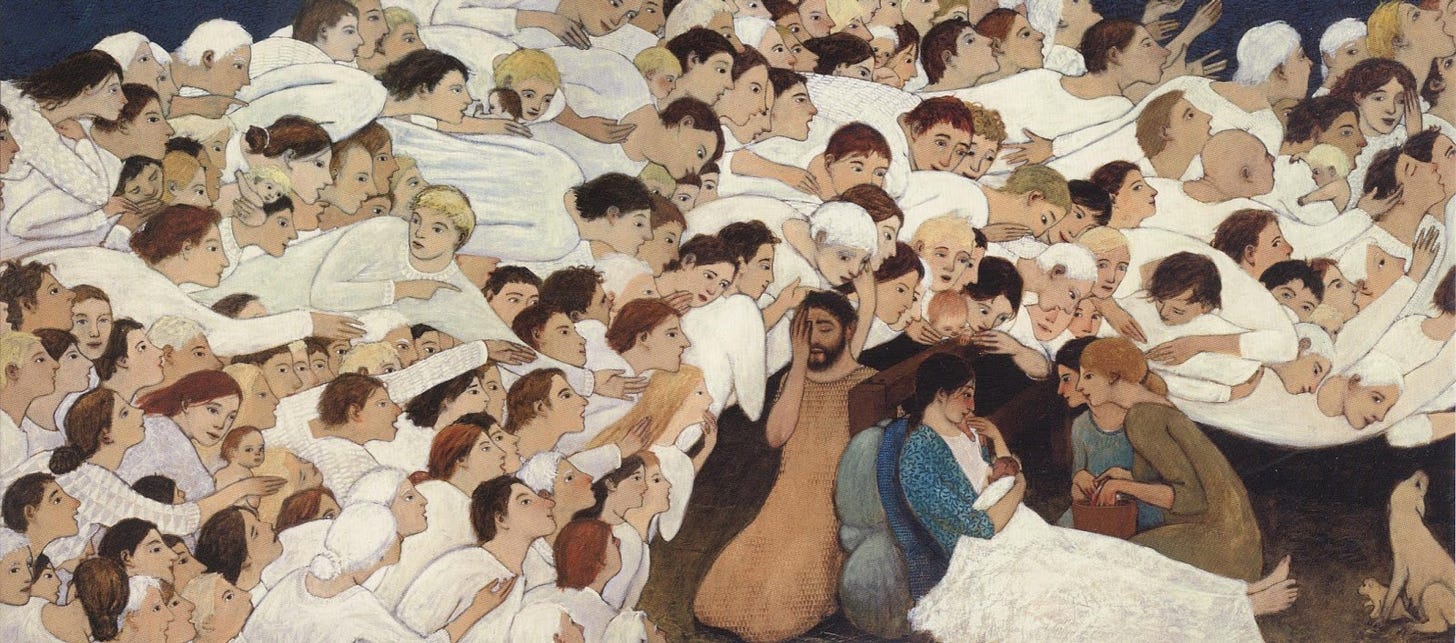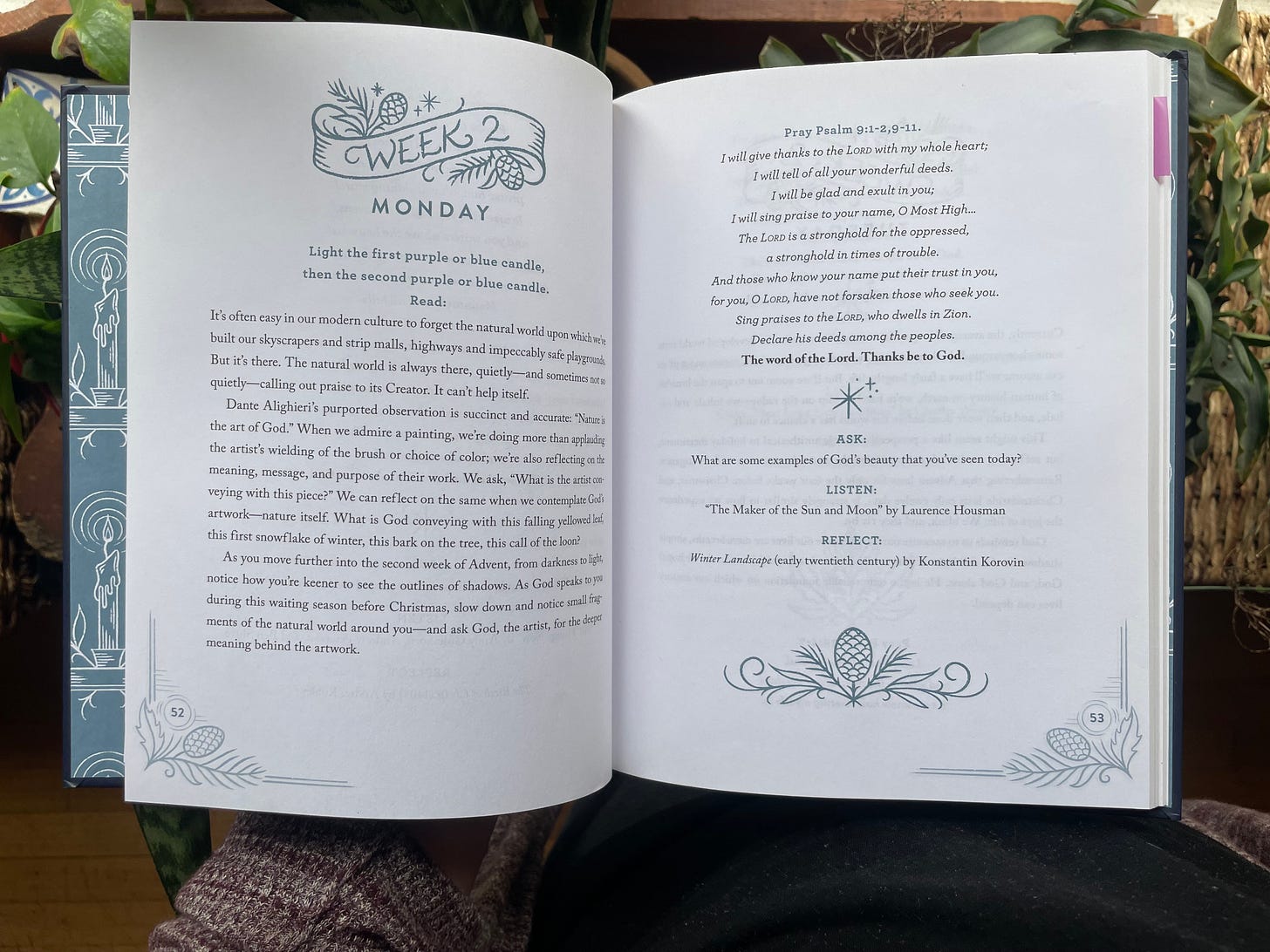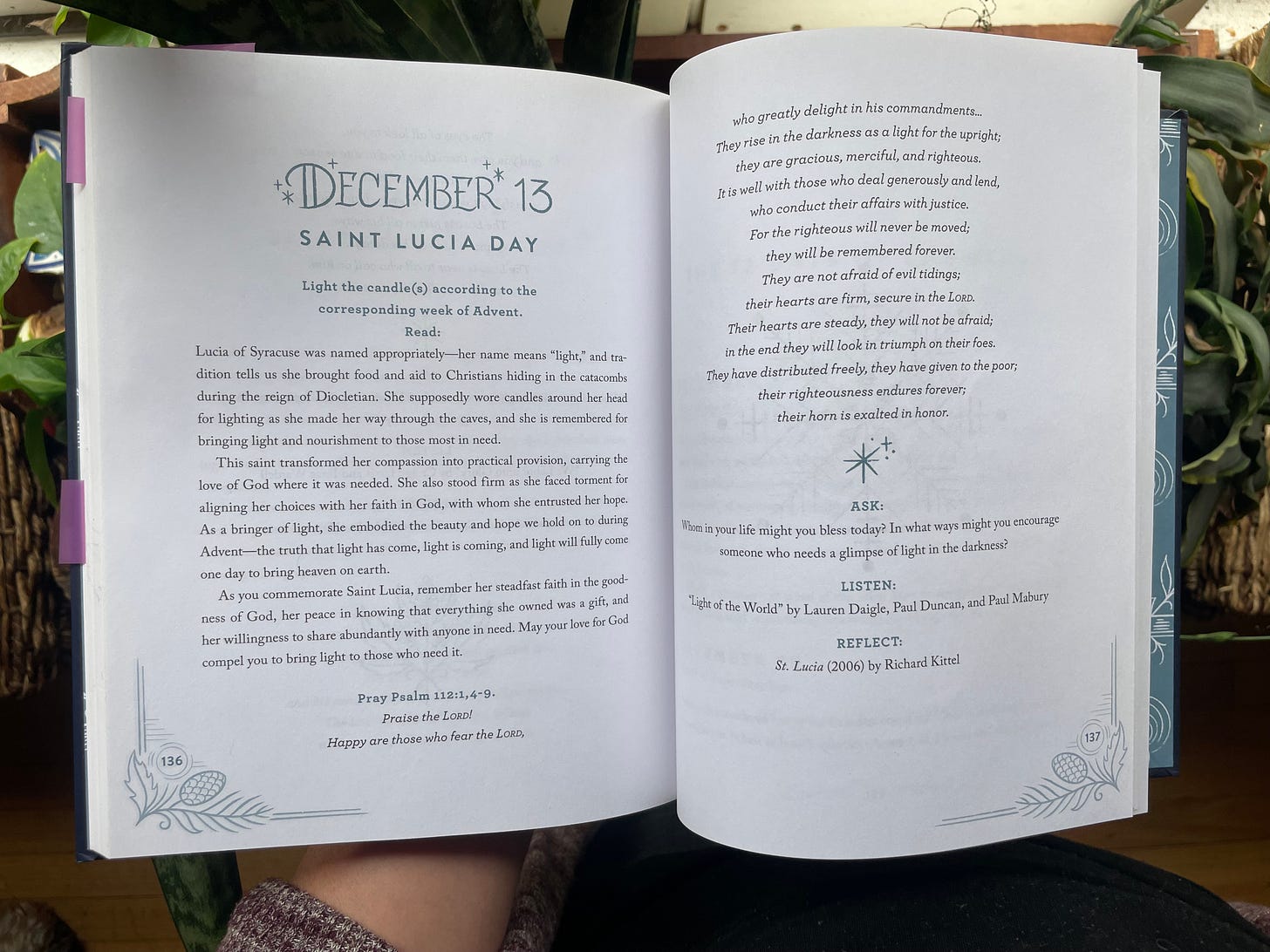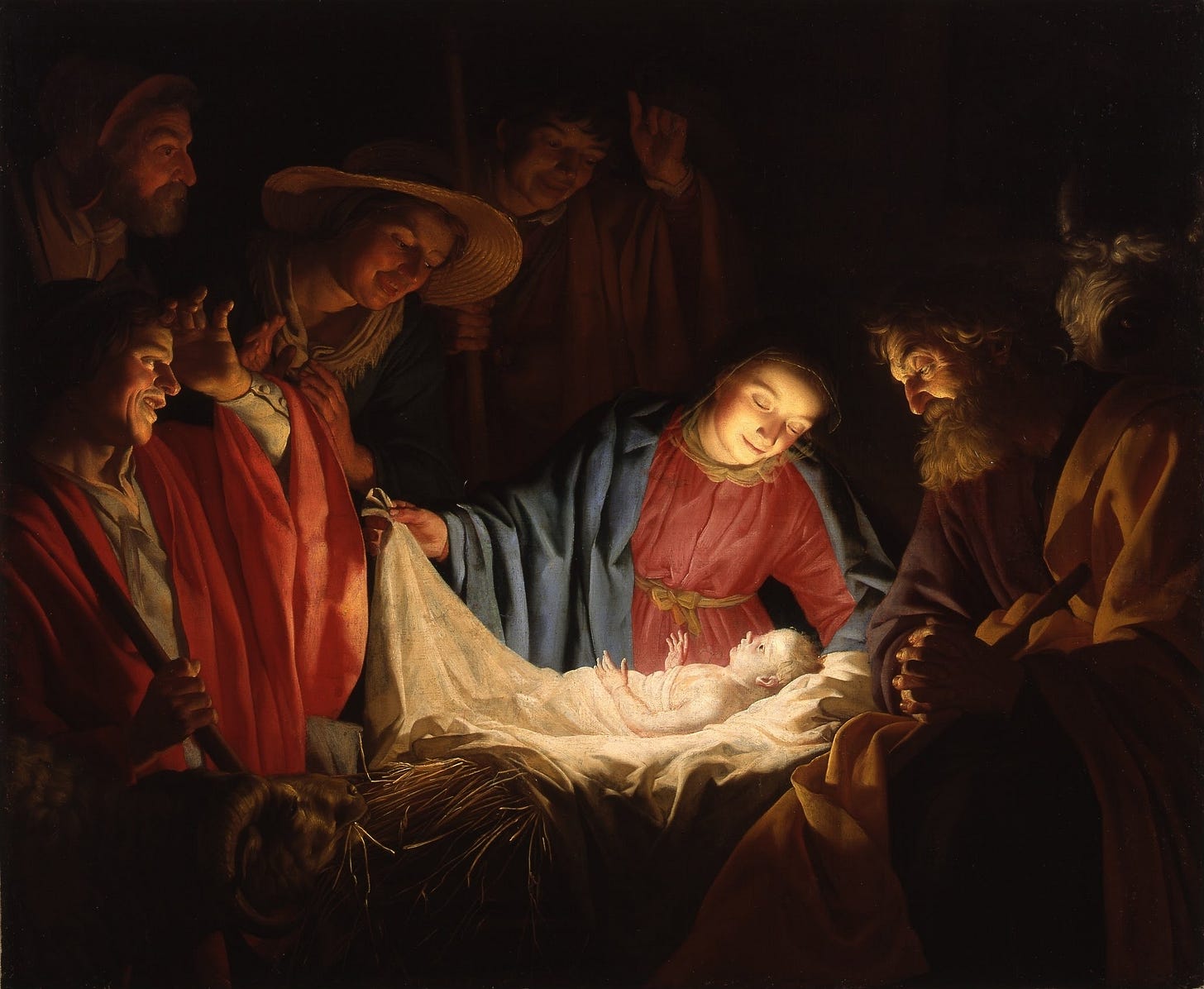A Brief What, Why, & How of Advent 🕯️
...because it's coming SOON
What is Advent? And what does it mean to “do” Advent? I’ve written about this extensively over the years, but consider this your mercifully short primer for this particular season, the refresher 101 course you didn't know you needed. After all, Advent is coming soon—I need this reminder, too.
What is Advent?
It’s the season in the Church’s liturgical calendar that begins on the fourth Sunday before Christmas Day and ends on Christmas Eve. It’s a penitential (fasting) season that exists to help us prepare ourselves inwardly and outwardly for the feasting season that follows: the twelve days of Christmastide, when we celebrate the earthly arrival of Jesus Christ, God incarnate in human flesh.
Okay. But can you say more?
Because of its fasting nature, Advent is sometimes thought of as a “little Lent” — during Advent we’re meant to engage in self-reflection, prayer, preparation for the upcoming feast, and a bit of self-denial. I say “a bit” because it's not quite as intense as the major penitential fasting season of Lent, the forty days leading to Easter, but it does call for us to engage in some discomfort for the purpose of growing our virtue and dependence on God.
The Church’s calendar as a whole is brilliantly structured to give its people exactly what it needs: seasons that ebb and flow with each other, to call us higher in virtue and deeper in recognizing our need for salvation. As such, I think it’s helpful to remember that there's never a season of fasting without a season of feasting that follows — the intentional self-denial isn't pointless, in other words; it's not a thing asked of us just to see if we can do it, if we can toughen up and somehow show God we're serious.
Advent, like the rest of the liturgical calendar, is a gift, not a to-do list. We are invited to participate in the universal Church's rhythm together with our brothers and sisters, and we can either leave the invite on the table or open the envelope and show up.
How does one “do” Advent then?
Like all fasting and feasting seasons, there are traditional recommendations for things to do, yet there’s an understanding that not everything is for everyone, nor in every season of life. Therefore, these traditions are encouraged, but they’re not required as though Advent is some qualifying trial event to see if you’re allowed to celebrate Christmas. Again, its purpose is to deepen our dependence on God and to help us grow in virtue.
That said, the broad practice of Advent simply involves fasting from something in order to prepare yourself for Christmas. Note how different that is from the assumed purpose of Advent out in the world: to count down the days until Christmas Day. Yes, there is that, too, but the countdown is in tandem with an inward journey toward the nativity, where on December 25 we begin a twelve-day season of gladness that God put on flesh for our sake. The weeks between Thanksgiving Day (in the U.S.) and Christmas Day aren’t yet the Christmas season. We're technically not “supposed” to be celebrating yet.
It’s a pregnant, already/not yet season of remembering that, yes, here and now in the twenty-first century we live in a post-resurrection world, where Christ has already physically come to the world—but that we don’t yet live in a post-returned Christ world, in which he promised to make all things new. We use Advent to intentionally recognize that the world isn’t, indeed, how it should be... yet. We look square in the face some of the injustices of the world, and we ask what we should do to participate in making God’s kingdom come to earth as it is in heaven.
So... fasting. Prayer. Remembering. Reflection. These are what we do during Advent.
Okay, gotcha. But really, brass tacks—how do we “do” Advent?
Understood. Here's how this might look practically for you, depending on your current season of life:
1. Fast.
Fast from something particular during the four weeks before Christmas: a food, a practice, a comfort, what have you.
As for me, I’ve been eating carnivore for several months, so I’ll continue fasting from sugar during Advent, but I also plan to add some Scripture and/or poetry memorization.1
2. Purposely ease in to the festive spirit in your home.
The world around you will be blaring “Jingle Bell Rock” and “All I Want For Christmas Is You” (if they aren't already; our local Home Depot certainly is). That’s okay. Don’t be a purist and cover your ears shouting “La la la la la!” if you walk into your coffee shop and Bing Crosby’s crooning in the background. You do, however, have control inside the four walls of your home. Gradually add the Christmas stuff: the decor, the movies, the music, the food.
The first few weeks of Advent, keep things super simple. Perhaps buy or set up your tree the first week. Then add the lights a few days later. Then, wait a week to get the ornament box down from the attic, and once you open it, festoon your tree slowly, every few days. Give yourself a visual reminder that you’re not yet celebrating, but you are preparing to do so. Purposely feel that anticipation when you’re hankering to put out all the stops immediately. Practice the maturity of delayed gratification. Encourage your kids that you’re eager for Christmas, too, and you’re practicing patience together.
Keep food simple those first few weeks: soups, low-cost proteins, repeated meals. The time for sugary treats will be here soon enough—remind your body alongside your mind that it’s a season of waiting, not celebrating. Not just yet.
Side note on all this: A beautiful benefit to leaning into practical Advent traditions like this is that you're not sick of it all [gestures broadly at the holidays] by December 25. Christmas will have just begun on that day! And you’ve got eleven more days afterward to celebrate. That is the time for cinnamon rolls, gingerbread cookies, and goofy Elf movies. Not to put your tree out on the curb on the 26th. The party’s just started.
Another side note: However, it really is important to not be an obnoxious purist about all this (believe me, I’ve been that person before, and I annoyed myself). The simple reality is our culture celebrates Christmas way, way, way earlier than it begins, sometimes months earlier. Still—go to the community events, join your neighbors in the holiday movie night, and enjoy the white elephant party. The general public isn’t trying to ruin Advent; most simply don’t know the difference between it and Christmas. Control what you can control—the inside of your home—and let go of the rest.
3. Light candles.
It’s a longstanding tradition to light one candle a week starting the first Sunday of Advent, culminating in four lit candles and sometimes a fifth Christmas candle on either Christmas Eve or Day. Traditionally the Advent candles are purple, to remind us of the penitential season, with the third week’s a rose color to remind us that we do have joy on the horizon. The Christmas candle is white.
This is an easy tradition to incorporate in our homes and kids usually love it. For years now we’ve rolled our own beeswax candles with kits like these or these (even our teens still enjoy the ritual), and our Advent “wreath” is a simple log from the backyard with five drilled holes for the candles. No need to over-complicate this.
That said, there are some lovely Advent wreaths and wreath rings here, here, and here.
And there are also plenty of pre-made beeswax Advent candles like these here, here, and here.
4. Read something and reflect.
Add a short devotional reading to accompany your candle-lighting tradition. This is exactly why I wrote Shadow & Light: I couldn't find anything to meet our family’s needs, so I wrote one for us, shared it with readers, and was popular enough that it eventually became a published book.
I was after something simple but meaningful, short but impactful, and open-and-go: meaning, no prep required, and if we had to skip a day or three because of our busy holiday schedule, no problem. (There are many beautiful Advent books that slowly build on a longer story, day at a time, but we’d run into the inevitable problem of having to miss enough days to culminate in an hour-plus long catch-up reading night — not ideal with little kids who just need to go to bed already).
Shadow & Light includes a daily short reflection written by me, a corresponding Psalm, a reflection question, and an accompanying song and work of art. It can be done together as a family or solo for a personal devotion. It also includes added days for Saints Nicholas and Lucia, as well as a twenty-five day reading of the story of Christ's arrival found in the Gospels, if you’d rather read that than (or alongside with) the Psalms.
Here’s the accompanying playlist:
And here’s all the artwork mentioned.
5. Add art.
To that last point, art adds dimension, beauty, and a purposeful pause to Advent’s whole rhythm. It’s easy to rush through a reading and candlelighting (and some evenings warrant it), but there’s also so much inward preparation God wants us to engage in, and art can help us do that. Centuries of artists have given us stunning music and contemplative visual art, and we’d be remiss not to take advantage of these gifts given to us by the communion of saints.
Bonus: we get to enjoy Advent hymns that are often overshadowed by their Christmas counterparts. I adore “Joy to the World” and “Hark! The Herald Angels Sing” as much as the next gal. But let’s not forget “Let All Mortal Flesh Keep Silence” and “In Labor All Creation Groans,” too.
These are my thoughts for why we should intentionally take a slower, more contemplative, penitential posture, and the practical suggestions for how we can do so. I’d love to hear from you what traditions have become some of your family’s favorites — or if you’ve never recognized Advent in your holiday traditions before, what you’d like to try this year for the first time. (Because that’s another thing: take it slow, especially if Advent is new to you. Don’t bite off too much and inadvertently make Advent a chore... Remember, it’s an invitation, not a to-do list.)
Give yourself the gift of a frantic-free first-Sunday-of-Advent weekend and get what you need now, this week: your candles and/or wreath, your devotional guide, and a marked reminder on the calendar that it begins soon and very soon.
Happy holidays, friends,
Tsh
As you may remember from the Lenten season, fasting can look like both taking away something and adding something.









Love this, and especially the reminder to not be a purist. Because so many of the Advent traditions we have are the result of years of change and interaction with regional customs over the centuries!
I'm wondering. I've always thought Advent was primarily for longing for and praying for the second coming? Love Shadow and Light. My women's group reads it every year.